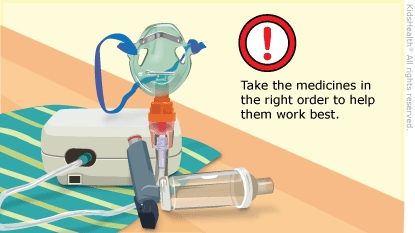Inhaled medicines are medicines that people breathe in. Kids with cystic fibrosis (CF) need inhaled medicines to help prevent lung infections and make it easier to breathe. Inhaled medicines work best when you give them in the right order. Here's how to do it.

What inhaled medicines do kids with CF need? Different types of medicines help kids with CF. Some kids don't need all of them.
Here's how the main types of inhaled medicines work:
- Bronchodilators relax and open the airways so air can move in and out of the lungs. Albuterol, Atrovent®, ProAir®, and Xopenex® all are bronchodilators.
- Hypertonic saline is a special type of saltwater. It helps thin mucus so a child can cough it up. HyperSal® is hypertonic saline.
- DNase (dornase alfa) breaks down a substance in mucus that makes it sticky. This helps loosen mucus so it moves out of the airways and a child can cough it up. Pulmozyme® is a DNase.
- Antibiotics kill bacteria (germs). It's important to clear out as much mucus as possible before inhaling an antibiotic. That way, the antibiotic gets deeper into the lungs to kill more germs. Brand names include Cayston®, TOBI®, and Coly-Mycin® M.
- Steroids (also called corticosteroids or glucocorticoids) reduce swelling in the airways.
- Some steroids are given alone. Brand names include Flovent®, QVAR®, Asmanex®, and Pulmicort®.
- Other steroids are combined with a bronchodilator. This is called a combined bronchodilator. Brand names include Advair® and Symbicort®.
How do ACTs help? "ACTs" stands for "airway clearance techniques." After inhaled medicines thin and break up mucus, ACTs help move it out of the lungs.
ACTs can include things like tilting the body, clapping on the back, wearing a special vest, or using a device that vibrates (shakes) the chest. Follow the care team's recommendations for what kind of ACT to do and when to do it.



